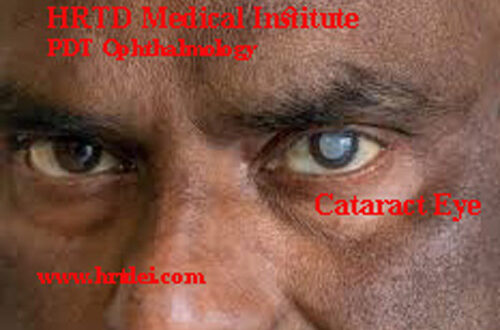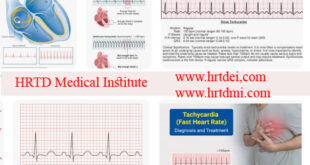Cataract Eye Details
Cataract Eye. Mobile Phone 01797-522136. Cataracts Eye is a common eye problem in aged people. It is the principal cause of blindness. There are some risk factors for cataract eye. For the prevention of Cataracts, we should be careful about the risk factors.

To know details about cataracts some courses are available in HRTD Medical Institute. The Courses are PDT Ophthalmology 6 Months, PDT Ophthalmology 1 Year, and PDT Ophthalmology 2 Years. Qualification for admission in the PDT Ophthalmology Course is a Diploma Medical or Short Diploma Medical Course Completed.
1. What is cataract of the eye
A cataract is a clouding of the eye’s natural lens which lies behind the iris and the pupil. An eye with a cataract is called a Cataract Eye.
2. What are the problems that arise due to cataracts
Cataracts are the most common cause of vision loss in people over age 40 and it is the principal cause of blindness.
3. Mention the types of cataracts
- Subcapsular cataract
- Nuclear cataract
- Cortical cataract
4. Define subcapsular cataract
A cataract that occurs at the back of the lens is called subcapsular cataract. An eye with a subcapsular cataract is called a subcapsular cataract eye.
5. Which people have a greater risk of developing subcapsular cataracts
People have a greater risk of developing subcapsular cataracts
- People with diabetes
- People who take high doses of steroid medications
6. Define nuclear cataract.
Cataracts that form deep in the central zone of the lens are called nuclear cataracts. An eye with a nuclear cataract is called a nuclear cataract eye.
7. Which is the most common factor of nuclear cataracts
Aging is the most common factor of nuclear cataracts.
8. Define cortical cataract.
A cataract that occurs in the lens cortex is called a cortical cataract. An eye with a cortical cataract is called a cortical cataract eye.
9. Mention the characteristics of cortical cataracts.
Characteristics of cortical cataracts are wedge-like opacities that start in the periphery of the lens and work their way to the center in a spoke-like fashion.
10. What are the components of the natural eye lens
The eye’s natural lens is made of water and protein.
The protein is arranged in a precise way that keeps the lens clear and lets light pass through it.
11. Mention the cataract development.
When we aged some of the protein of our lens may clump together and start to cloud a small area of the lens. It may grow larger and cloud more of the lens. Nobody knows clearly why cataracts form when we aged.
12. Mention the risk factors of cataracts
The risk factors of cataracts are
- Ultraviolet radiation
- Diabetes
- Hypertension
- Obesity
- Smoking
- Long-time use of corticosteroid medications
- Statin medicines are used to reduce cholesterol.
- Previous eye injury or inflammation
- Previous eye surgery
- Hormone replacement therapy
Significant alcohol consumption
- High myopia
- Family history
13. Which is the believable theory of cataract formation
Cataracts are caused by oxidative changes in the human lens
This theory is supported by nutrition studies. Nutrition studies show fruits and vegetables high in antioxidants may help prevent certain types of cataracts.
14. Mention the prevention of cataracts
Prevention of cataracts:
- Antioxidant vitamins. Like vit c,vit E
- Omega 3 fatty acids enrich food
- Use of sunglasses that block 100% UV rays.
15. Mention the treatment of cataracts
At the primary stage when symptoms begin to appear vision may be improved by
- Appropriate lighting
- Glasses with lens
At the secondary stage when vision is seriously impaired
- Cataract surgery
16. Define cataract surgery
Cataract surgery is a kind of surgery where a natural cloudy eye lens is removed and replaced with an artificial lens (intraocular lens or IOL) To restore clear vision.
17. Why it is called subcapsular cataract
It is called a subcapsular cataract because it forms beneath the lens capsule. A subcapsular cataract is a small sac or membrane that encloses the lens.
18. What are the signs and symptoms of cataract eye
Signs and symptoms of cataract eye:
- Clouded, blurred, or dim vision
- Increasing difficulty with vision at night
- Sensitivity to light and glare
- Need brighter light for reading and other activities
- Seeing halos around lights
- Frequent changes in eyeglasses or contact lenses.
- Fading or yellowing of colors
- Double vision in a single eye.
19. What are the causes of diplopia (Double vision)
Usually, there are six causes of diplopia or double vision.
- Stroke, head injury, brain tumor brain swelling, or brain aneurysm.
- Corneal irregularities
- Dry eyes
- Refractive surgery
- Cataracts
- Cranial nerve palsies
20. How cataracts cause double vision or ghost image
Cataracts may cause ghost images usually in our eyes only. This is because the clouding of the eye’s natural lens can cause light rays to scatter in different directions, creating multiple but incomplete images, especially when looking at light.
21. How to solve ghost image or double vision problem due to cataracts
Cataract surgery soles the ghost image or double vision problem due to cataracts
22. What is the treatment of ghost image due to dry eye
Treatment of ghost image due to dry eye Continuous treatment of dry eye by Artificial tear eye drops such as Hypromellose eye drops.
Tear eye drop
Or Tearsol eye drop
Or, Natural tear eye drop
 MATCDHAKA – Medical Assistant Training Centre in Dhaka Pharmacy, Veterinary, Dental, Nursing, Pathology, Physiotherapy and Homeopathy Training Institute in Dhaka
MATCDHAKA – Medical Assistant Training Centre in Dhaka Pharmacy, Veterinary, Dental, Nursing, Pathology, Physiotherapy and Homeopathy Training Institute in Dhaka






